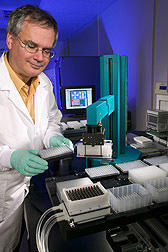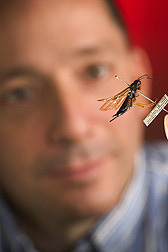This page has been archived and is being provided for reference purposes only. The page is no longer being updated, and therefore, links on the page may be invalid.
|
Read the magazine story to find out more. |
|
|
State-of-the-Art Technology Being Applied to Agricultural Problems
By Alfredo FloresJuly 13, 2006
Armed with the latest high-tech research equipment, Agricultural Research Service (ARS) scientists in Mississippi are investigating the genetic secrets of catfish, cotton, soybeans and other crops.
The goal of scientists at the ARS Mid South Area Genomics Laboratory in Stoneville, Miss., is to improve these commodities by learning more about their genetic makeup. The genomics lab was formed in 2000 to meet the genetic sequencing needs of 14 research locations in five states.
Crops under study include cotton, soybeans, rice, sugarcane and catfish. The genomics lab is part of the Jamie Whitten Delta States Research Center at Stoneville.
ARS computational molecular biologist Brian Scheffler, in the center's Catfish Genetics Research Unit (CGRU), leads operations in the genomics lab. He uses high-throughput DNA sequencers, robotics, bioinformatics computers, and other modern equipment to conduct marker-assisted breeding. Scheffler helps researchers use the lab to tap into the genetic information of whatever species they might be studying in order to find solutions to agricultural problems.
To identify the gene responsible for a certain feature or trait, researchers use genetic landmarks known as DNA markers, which can be a gene or a section of DNA with no known function. The markers can tell them roughly where a particular gene is located on a chromosome. When a DNA marker is associated with a physical trait, such as disease resistance, this helps guide breeders to more effectively add, delete or modify desirable traits in farm crops or animals.
Working with the genomics lab, one CGRU researcher has adapted a bacterial artificial chromosome, or BAC, DNA fingerprinting technique for high-throughput genetic analysis. This will be helpful in constructing a physical map that will aid identification of genes affecting catfish production traits and could one day contribute to determining the catfish genome.
ARS researchers in Houma, La., are using the marker technology and the genomics laboratory's high-throughput technology to help develop new sugarcane varieties by showing which seeds are the result of cross-breeding experiments and which were self-pollinated. The laboratory has also been instrumental in determining 70,000 expressed sequence tags (ESTs) from upland cotton. These short sequences of DNA greatly reduce the time required to locate a specific gene and will help in the identification of genes important in cotton fiber development.
Read more about the research in the July 2006 issue of Agricultural Research magazine.
ARS is the U.S. Department of Agriculture's principal scientific research agency.


